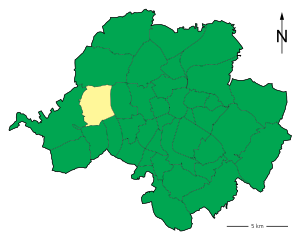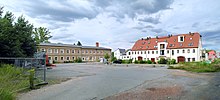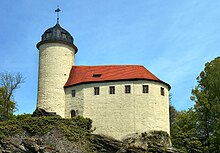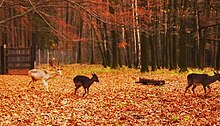Chemnitz-Rabenstein
|
Rabenstein district and statistical district No. 94 of Chemnitz |
|
|---|---|
| Coordinates | 50 ° 49 '50 " N , 12 ° 49' 25" E |
| height | 314– 416 m above sea level NN |
| surface | 7.01 km² |
| Residents | 4362 (Dec. 31, 2013) |
| Population density | 622 inhabitants / km² |
| Incorporation | Jul 1, 1950 |
| Post Code | 09117 |
| prefix | 0371 |
| Transport links | |
| Highway |
|
| bus | 32, 43, 73, 253, N16 |
Rabenstein is a district of the city of Chemnitz in Saxony . The community emerged in 1897 from the previously independent communities Oberrabenstein and Niederrabenstein and was incorporated into Chemnitz in 1950.
geography
Rabenstein is located on the conservation area " Rabensteiner forest " consisting essentially of the "Rabenstein mountains". This ridge separates the northern edge of the Erzgebirge basin from the southern edge of the central Saxon loess loam area - so Rabenstein can be described as the "gate of the Erzgebirge ". The broad Rabensteiner ridge drops steeply over 100 meters to the Erzgebirge basin. The altitude is 314 to 416 meters above sea level .
The districts of Röhrsdorf , Rottluff , Siegmar , Reichenbrand and Grüna border Rabenstein .
Pleißenbach
The Pleißenbach , which flows on the corridor border with Rottluff, has its source in the municipality of Callenberg on the Langenberger Höhe. With its 20 km it is the longest tributary of the Chemnitz River . In 1402, "daz wasser dy Plyßen" is mentioned for the first time in a document.
history
In the middle of the 12th century, the Rabenstein rule came into being in the course of the settlement of the Erzgebirge Forest during the German expansion to the east. A castle was built as the center of rule and settlement by the Lords of Waldenburg , then referred to as Schloss Rabenstein.
Oberrabenstein was created under the protection of this castle. On a lane that led up to the castle, a settlement of houses formed from trades that previously belonged to the castle, such as blacksmith, miller, brewer and wheelwright, etc. so the place was called Gasse or Rabensteiner Gasse until the century before last. Niederrabenstein ("Steyn" in 1375, "Nieder Rabenstein" in 1696) was created as a Waldhufendorf , just like the other places in the Rabenstein domain .
The Chemnitz Benedictine monastery acquired the old Rabenstein rule in 1375, which led to the Rabenstein feud in 1383 . Both places came to the office of Chemnitz after the secularization of the monastery in 1548 .
In the 19th century Niederrabenstein developed into an industrial community. There were mainly produces socks and knitted gloves, there was also a brewery and a brandy distillery . As a result of this industrialization, an increased influx of people began in Niederrabenstein from 1852, a new parish was formed, whereby the Niederrabensteiner Church of St. Georg was built from 1852 to 1854 .
Oberrabenstein has retained its rural character to this day. Since the opening of the "Oberrabenstein Reservoir" outdoor pool in 1976, it has been a popular local recreation area. Ober- and Niederrabenstein were united on October 1, 1897 to form the municipality of Rabenstein. Rabenstein was incorporated into Chemnitz on July 1, 1950.
Niederrabenstein manor
Georg von Carlowitz acquired four farms in Niederrabenstein in 1576 and received lower jurisdiction from the Saxon elector in 1590 and high jurisdiction in 1602. The Niederrabenstein manor came into being when the village of Niederrabenstein was transferred to the family as a hereditary fief. In 1619 his descendant Hans Georg also acquired the castle with the Rabensteiner Gasse ( Oberrabenstein ) and thus formed a new rule Rabenstein , which was divided from 1671 onwards. In 1686 the Niederrabenstein estate was sold. The castle and manor Oberrabenstein remained in the possession of the Carlowitz family until 1774, after which both passed into civil ownership. His owners included u. a. Georg Ludwig von Welck (1809–1838).
Attractions

Sights in this district include the Rabenstein Castle and Castle, the "St. George Church" - one of the first churches in Saxony in the neo-Gothic style with an altar by Ernst Rietschel , the "Felsendome" mine in Niederrabenstein , the outdoor pool " Stausee Oberrabenstein "(where the hip-hop festival" Splash "took place from 1999 to 2006 ), the Pelzmühlenteich followed by a café and the" Tierpark Chemnitz ", as well as the DRK hospital on Unritzstrasse and the clinic" Carolabad "on the Riedstrasse . The “Rabenstein-Center” shopping center is located at the intersection of Oberfrohnaer Strasse and Trützschlerstrasse .
Kulturpalast Rabenstein
In the 1950s, the Rabenstein Palace of Culture was built near the Pelzmühlenteich on Pelzmühlenstrasse . After the political change in the GDR , it was used by the MDR . In 2012 it was empty. The Kulturpalast Rabenstein is one of the most important cultural buildings in early post-war history.
Rabenstein Castle
The Rabenstein Castle , the smallest Medieval castle in Sachsen, and was first mentioned in the 1336th The castle was probably built around 1170. At first it was owned by the Lords of Waldenburg , from 1375 it belonged to the Chemnitz Benedictine monastery. From 1619 until the 18th century it belonged to the Carlowitz family . On December 14, 1645, Hans Carl von Carlowitz was born at Rabenstein Castle. In 1713 , with his work “ Sylvicultura oeconomica ”, he developed the concept and principle of sustainability . A renovation of the castle can be proven as early as 1819. In the meantime it has become a popular excursion destination and had to be closed in 1942 due to the risk of collapse. In 1955/1956 it was renovated again and made accessible again in 1959.
Rabenstein rock dome
In the “Niederrabenstein lime works”, which was closed in 1906, there is now a show mine not far from the A 72 motorway . This lime mine must have been in operation as early as 1365. It has been open to visitors since 1936.
In the former mine you can see the relatively small stalagmites and stalactites , as well as the many small watered grottos. Even bats live here in winter.
Wildgatter Oberrabenstein
The Wildgatter Oberrabenstein welcomes its guests since 1973. On an area of 35 hectares, a circular path and viewing platforms offer the visitor the opportunity to observe exclusively European animal species in spacious enclosures. There is also a nature trail. The area of the Wildgatter, which has been part of the Chemnitz Zoo since 1995, extends into the Rabensteiner Forest. The Oberrabenstein reservoir , Rabenstein Castle and a campsite are in the immediate vicinity .
traffic
The A 72 runs to the east of Rabenstein . From the “Chemnitz-Rottluff / Chemnitz-Rabenstein” junction, take the Kalkstaße motorway slip road to Rabenstein. Furthermore, runs to the north the A4 with the exit "Limbach-Oberfrohna / Chemnitz-Rabenstein".
Rabenstein is connected to local public transport by bus routes 32, 43, 73, 253 and N16 of the night network.
An old railway viaduct, the so-called Rabensteiner Viaduct, spans the Oberfrohnaer Straße not far from the former Rabenstein (Sachs.) Train station . This building is now a technical monument , as it is considered one of the first bridges to use high-quality steel instead of iron .
Sports
Various sports clubs are based in Rabenstein. The largest of these is SG Handwerk Rabenstein, which, in addition to soccer, is also active in table tennis, badminton, gymnastics, athletics and fishing. There is also the archery club Chemnitz-Rabenstein and the TC Grün-Weiß Rabenstein, which has a long tradition in tennis. The cycling club HRV Chemnitz-Rabenstein organized the indoor cycling world championships in 2006 . Furthermore, the 24-hour Heavy 24 MTB race is held annually at the Oberrabenstein reservoir.
Personalities
- Hans Carl von Carlowitz (1645–1714), camera operator and chief miner
- Johann Michael Freyberg (1725–1774), Lutheran theologian and pastor in Niederrabenstein
- Guido Alfred Dost (1859–1929), elementary school teacher, composer, local historian and dialect poet of the western Ore Mountains
- Fritz Hartmann (1906–1974), Gestapo chief of Trier and Luxembourg
- Achim Mehlhorn (* 1939), chemist
- Martin Petzoldt (1946–2015), theologian and Bach researcher
literature
- The 1000 year old Rabenstein Castle. Festschrift for the Heimatfest 13. – 15. June 1936 on the occasion of the 600th anniversary of the first documentary mention. A contribution to local history. (published on behalf of the festival committee by Dr. Steinbrück, school director in Rabenstein) Printed by Willy Gröer, Rabenstein 1936. (120 pages)
- Joachim Preißler: The Rabensteiner underground rock domes . Karl-Marx-Stadt 1962.
- Lothar Schilde: The Kulturpalast. The history of the house from the beginning to the present. Printed by Willy Gröer, Rabenstein o. J. (76 pages)
- Rudolph Strauss: New research results on the history of the Rabensteiner underground rock domes. In: Sächsische Heimatblätter , issue 5/1977, pp. 210–215.
Web links
- Rabenstein in the Digital Historical Directory of Saxony
- Niederrabenstein in the Digital Historical Directory of Saxony
- Oberrabenstein in the Digital Historical Directory of Saxony
- Website about Rabenstein
Remarks
- ↑ a b c The Pelzmühlen area and the zoo are now part of the Reichenbrand district
Individual evidence
- ↑ Fitzcarraldo's dream. Rescuer wanted. The Kulturpalast Rabenstein near Chemnitz is threatened with demolition. In: Frankfurter Allgemeine Zeitung of July 16, 2011, page 34
- ^ Chemnitzer Verkehrs-AG (CVAG) | Line timetables. Retrieved June 2, 2020 .
- ↑ SG Handwerk Rabenstein - club homepage. Retrieved June 2, 2020 .
- ^ Archery Club Chemnitz-Rabenstein e. V. (Chembows). Accessed June 2, 2020 (German).
- ↑ Grün-Weiss tennis club. Retrieved June 2, 2020 .
- ↑ When a small club became known worldwide | Free press - Chemnitz. Retrieved June 2, 2020 .
- ↑ Heavy24 start page. Retrieved June 2, 2020 .









